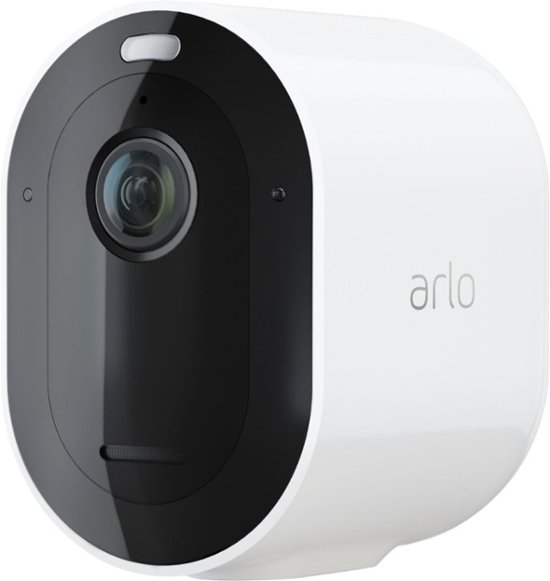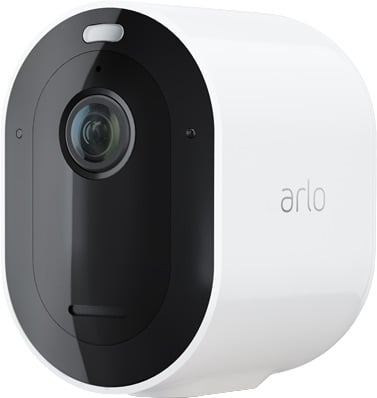Buy as a standalone
Arlo Pro 4
Pros
- Camera can connect directly to router
- More affordable as a standalone device
Cons
- No local storage without Arlo Smart Hub
- Functionally identical to Pro 3; no new features
Arlo's newest Pro model is virtually identical in specs to the Pro 3, but has one extremely important upgrade: it can connect directly to your Wi-Fi network with no need for a separate accessory. Just be ready to pay for cloud storage, since you need a hub for local storage.
Buy for local storage
Arlo Pro 3
$300 at Amazon (2-Camera System)
Pros
- Cheaper per camera with same specs as Pro 4
- Smart hub comes with local storage
Cons
- Requires smart hub to operate
- Smart hub + cameras are expensive
- 2K mode requires specific smart hub to work
Don't just buy an Arlo Pro 3 by itself. You can't use one without a compatible smart hub or base station to connect to your network. However, a smart hub has its perks, and if you're going to use one anyway, the Pro 3 has the same specs as its successor at a slight discount.
Comparing the Arlo Pro 4 vs. Pro 3 is a bit like trying to tell two identical twins apart. They're literally the same size and weight, and match one another in resolution, field of view, night vision, and virtually every other home security category. However, there's one key difference between them, which will make it simple for you to decide which is the best Arlo camera for you.
Arlo Pro 4 vs. Pro 3 Specs
We won't hold you in suspense: you won't find many differences between the two models in the Arlo Pro spec table below. The quality of the footage, day or night, won't change. Both come with a wall mount, magnetic charging cable and replaceable battery pack, and have the weather resistance to be mounted either outdoors or indoors. They both work with most smart homes, but also require a paid Arlo Smart subscription to get cloud storage and advanced AI detection. You can see all the similarities below, and we bolded any category with differences.
| Arlo Pro 4 | Arlo Pro 3 | |
|---|---|---|
| Dimensions | 316g; 89mm x 52mm x 78.4mm | 316g; 89mm x 52mm x 78.4mm |
| Smart hub required | No; can connect camera directly to router | Yes |
| Max Resolution | 2560x1440 | 2560x1440 |
| Video Modes | 2K 1080p 720p |
2K (only with Pro 3 Smarthub or Ultra Smarthub) 1080p 720p |
| Lens FOV | 160 degrees diagonal | 160 degrees diagonal |
| Motion Detection FOV | 130 degrees diagonal | 130 degrees diagonal |
| Night Vision | Color; 850nm infrared detection | Color; 850nm infrared detection |
| Spotlight | 6500K, 42Lux @1M | 6500K, 42Lux @1M |
| Digital Zoom | 12X | 12X |
| Sound Detection | Yes | Yes |
| 2-way Audio | Yes; uses single mic with noise and echo cancellation | Yes; uses single mic with noise and echo cancellation |
| Built-in Siren | Yes | Yes |
| Battery | 3-6 months | 3–6 months |
| Operating Conditions | -20–45 degrees Celsius (-4–113 degrees Fahrenheit) Water resistant |
-20–45 degrees Celsius (-4–113 degrees Fahrenheit) Water resistant |
| Smart Home Compatibility | Amazon Alexa, Google Assistant, Apple HomeKit, IFTTT | Amazon Alexa, Google Assistant, Apple HomeKit, IFTTT |
| AI Features with Subscription | People, package, animal or vehicle detection | People, package, animal or vehicle detection |
| Upload Data Usage | 2-4Mbps | 2-4Mbps |
| Storage | Cloud storage requires subscription Local storage requires smart hub and USB 2.0-compatible drive |
Cloud storage requires subscription Local storage: connect USB 2.0-compatible drive to smart hub |
Arlo Pro 4 vs. Pro 3 Smart hubs and storage
You need an Arlo base station or smart hub in order to use the Arlo Pro 3, whereas the Arlo Pro 4 is compatible with them but can also sync up to your Wi-Fi network directly. You can buy an individual Pro 3 for cheaper than a Pro 4, but it's just a paperweight unless you already own a compatible hub: a VMB4540 or VMB5000.
While we appreciate that the Pro 4 lets you skip the smart hub, some people should seriously consider getting a hub regardless. Older Arlo Pro models gave you seven days of cloud storage by default, but the Arlo Pro 3 and Pro 4 have no free cloud storage, meaning you must either pay monthly for the cloud or store locally by connecting a USB flash drive to the Arlo smart hub.
The Arlo Pro 4 versus Pro 3 comes down to whether you want cloud storage, local storage or both.
Arlo claims that its smart hub has other benefits besides enabling local storage. While the Pro 4 can link up directly to your network and upload footage to the cloud, the smart hub can "protect your footage by adding a secure, personal network to your router." Plus, using a hub can reportedly improve your camera's battery life. They're supposed to last six months per charge, but may fall short of that under the wrong conditions. You'll have to pay upfront for a hub and storage drive, but then won't have to pay monthly for cloud storage.
On the other hand, you could make a case to ignore the local storage option and invest in an Arlo subscription instead. Along with 30 days of video history, an Arlo Premiere Plan makes your Pro 3 or Pro 4 smarter. You'll get intelligent alerts saying if the detected motion is coming from a person, vehicle, or pet, and it can recognize packages and notify you if one has been dropped off on your porch. Plus, it's the only way to set activity zones, ensuring that it only detects motion in your driveway and doesn't get a bunch of false positives from the street or sidewalk.
If you're going to pay monthly anyway to make your Arlo Pro 4 smarter, a smart hub with local storage may not be necessary. So, considering both cameras are functionally the same, your decision should focus entirely on price.
Arlo Pro 4 vs. Pro 3 Which should you buy?
Are you looking for a single camera or a surveillance system? If you just want one camera, the Arlo Pro 4 is the obvious choice because it can work independently without making you waste an outlet on a smart hub. If you need a family of security cams, the question is more complicated.
Single-camera shoppers should go with the Arlo Pro 4, while multi-camera buyers should focus entirely on whichever package is cheaper.
As of publication, there is a major discount on a two-camera Arlo Pro 3 bundle with smart hub, making it cheaper to get than buying two Arlo Pro 4s. Since these cameras are functionally identical, our current recommendation would be to get the Arlo Pro 3 bundle, so you can save money and have the option for local storage. However, that sale price could end at any time, and normally this bundle costs $500 — about the same price as a three-camera bundle of Arlo Pro 4s.
You should make your choice entirely based off of what deals you can find online. If the pricing is the same, you can choose the Arlo Pro 3 for more storage options, but we wouldn't recommend paying extra for the privilege.
Of course, both the Arlo Pro 4 and Pro 3 can be fairly expensive when bought in bulk. Anyone seeking total home security at a lower price may want to look into one of the best budget home security systems instead. The best home security systems with cameras can give you both camera- and sensor-based protection.
A reliable standalone camera
Arlo Pro 4
2K resolution, color night vision, and six-month battery life
$180 at Best Buy $500 at Best Buy (3-camera bundle)
Looking for a premium camera with premium specs? Look no further than the Arlo Pro 4, which can function both indoors and outdoors, can capture excellent-quality footage, and shouldn't need recharging very often. Just be ready to pay for cloud storage and AI detection.
Dependent on a smart hub
Arlo Pro 3
Store your 2K video footage locally
$155 at Amazon (1 Camera) $300 at Amazon (2-Camera System) $500 at Best Buy (4-Camera System)
If you don't trust your security company with your private footage on the cloud, then you'll need an Arlo smart hub for local storage. The Arlo Pro 3, functionally the same camera as the Pro 4, is your best option if you plan on buying one.
Source: androidcentral




